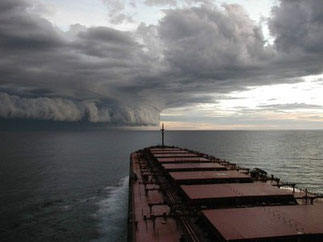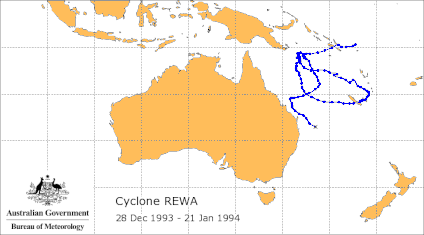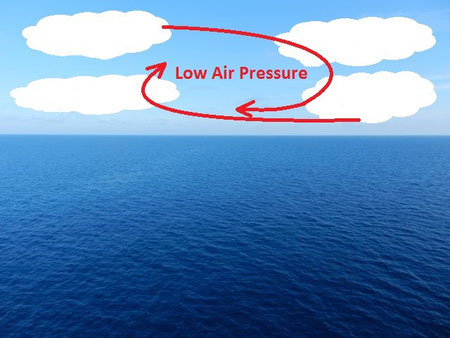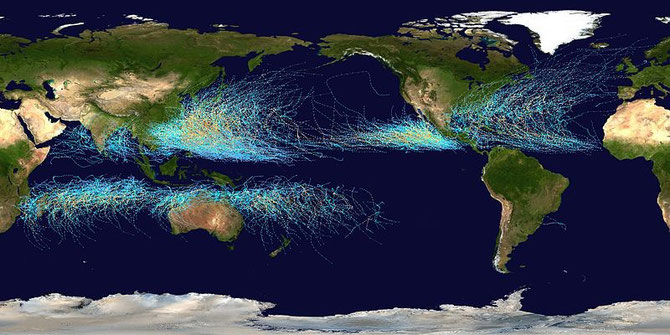Tropical Cyclones
What is a Tropical Cyclone?
A tropical cyclone (TC) is an intense rapidly rotating storm system characterized by a low-pressure center, strong winds, and a spiral arrangement of thunderstorms that produce heavy rain.
Tropical cyclones form over warm oceans and can wreak havoc when they approach the shore.

How long does a Tropical Cyclone last?

Tropical cyclones can persist for many days. They may follow quite erratic paths and usually dissipate over land or colder oceans.
How long a tropical cyclone lasts is determined by how favourable the atmospheric environment is; cyclone movement; and sea surface temperatures. While most cyclones undergo a life-cycle of 3-7 days some weak ones only briefly reach gale force while others can be sustained for weeks if they remain in a favourable environment.
Cyclone Rewa formed northwest of the Solomon islands on 28 December 1993 and finally decayed below cyclone strength in the Coral Sea east of Brisbane 24 days later on 21 January 1994.
The longest lived tropical cylone in the Southern Hemisphere was tropical cyclone Freddy Read More
What are Tropical Cyclones called in the Northern Hemisphere?

Tropical cyclones are called hurricanes in the Atlantic and Eastern Pacific, typhoons in Southeast Asia, and cyclones in the Indian Ocean and Western Pacific around Australia.
Tropical Cyclone Yasi track. Image from www.bom.gov.au, CCBY.
How are cyclones formed?
Tropical cyclones derive their energy from the warm tropical oceans and do not form unless the sea-surface temperature is above 26.5°C.
They derive their energy through the evaporation of water from the ocean surface, which ultimately re-condenses into clouds and rain when moist air rises and cools to saturation.
Once formed, Tropical cyclones can persist over lower sea-surface temperatures.
Tropical Cyclones require the difference in speed of rotation of the Earth at different latitudes to gather momentum as they spin.

The formation of a Tropical Cyclone has a number of stages
1) Initially a low air pressure system (depression) with convection currents starts to gather moisture and clouds begin to develop.
Tropical cyclones begin with continuous cloud build up even during the night time. The sun helps to heat the ocean and produces water vapour that forms clouds.

2) The second phase of Tropical Cyclone formation is linked with a low air pressure system that starts to pull clouds in and rotate.
It's not quite a Tropical Cyclone at this stage but most likely to develop into one.
3) The third phase is when the clouds start to rotate with some speed, at this point the Tropical Cyclone has developed and it may increase or decrease in size.
At this stage the Tropical Cyclone is mature and developed, It can be in it's full maturity stage but may develop further in intensity.
The Eye of a Tropical Cyclone

At the center of a mature Tropical Cyclone, air sinks rather than rises. For a sufficiently strong storm, air may sink over a layer deep enough to suppress cloud formation, thereby creating a clear eye. Weather in the eye is normally calm and free of clouds, although the sea may be extremely violent. The eye is normally circular in shape, and is typically 30–65 km in diameter, though eyes as small as 3 km and as large as 370 km have been observed.
Where do Tropical Cyclones occur?
Tropical Cyclones occur in the world's tropical regions.
Tropical Cyclones can form either side of the equator within + or - 5° to 15° latitude from the equator over the ocean however tropical cyclones do not form in the Southeast Pacific and the South Atlantic Oceans, where environmental conditions are not favorable.
In Australia tropical cyclones occur most frequently off the northwest coast of Western Australia, in the Gulf of Carpentaria and in the Coral Sea. The section of coast most frequently impacted by cyclones is around Port Hedland (WA).

Tropical Cyclone tracks

The pathway that a Tropical Cyclone takes once it is categorized as a cyclone is called a Tropical Cyclone track.
As the Tropical Cyclone develops from an intense low pressure system into a fully developed Tropical Cyclone a forecast of the track is published by the Bureau of Meteorology.
The actual post event cyclone track including its category is recorded and published for every event eg see the Tropical Cyclone
Yasi track at http://www.bom.gov.au/cyclone/history/yasi.shtml#track
Tropical Cyclone effects

Tropical cyclones out at sea cause large waves, heavy rain and high winds, often disrupting shipping and, at times, causing shipwrecks.
Tropical cyclones stir up water, leaving a cool wake behind them, which causes the region to be less favorable for subsequent formation of tropical cyclones.

On land, strong winds can damage or destroy vehicles, boats, buildings, bridges, and other outside objects, turning loose debris into deadly flying projectiles.
The storm surge, or the increase in sea level due to the cyclone, is typically the worst effect from land-falling tropical cyclones, historically resulting in a large proportion of tropical cyclone deaths.
How are Tropical Cyclones categorised?
Tropical Cyclones are categorised in the Australian region based on wind strength and these typical effects.
| Category | Strongest Gust (kM/Hr) | Typical effects |
| 1 Tropical Cyclone | Less than 125 km/hr gales | Minimal house damage. Damage to some crops, trees and caravans. Boats may drag moorings. |
| 2 Tropical Cyclone |
125 - 164 km/hr destructive winds |
Minor house damage. Significant damage to signs, trees and caravans. Heavy damage to some crops. Risk of power failure. Small boats may break moorings. |
| 3 Severe Tropical Cyclone |
165 - 224 km/hr very destructive winds |
Some roof and structural damage. Some caravans destroyed. Power failure likely. |
| 4 Severe Tropical Cyclone |
225 - 279 km/hr very destructive winds |
Significant roofing and structural damage. Many caravans destroyed and blown away. Dangerous airborne debris. Widespread power failures. |
| 5 Severe Tropical Cyclone |
More than 280 km/hr extremely destructive winds |
Extremely dangerous with widespread destruction. |
Resource: Some tropical cyclone information modified from http://en.wikipedia.org/wiki/Tropical_cyclone
Tropical Cyclone categories. Further
information: Cyclone intensity & impacts . From http://www.bom.gov.au/cyclone/about/intensity.shtml
(CCBY).
